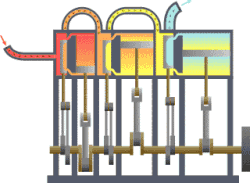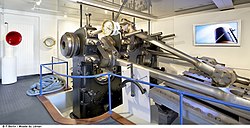Popular Science Dec 1918 p23 - Ship Emergency Steam Cutoff Valves
The torpedo strike had either killed the ship's engineers or cut off contact with them, and there was no means for anyone else to shut down the engines.
In December 1918, Popular Science Monthly reported that this problem had occurred so many times to other ships after the sinking of the Lusitania, that the British Board of Trade suggested that every passenger-carrying ship be provided with some means of stopping the engines from the deck or skylight hatchway. The magazine illustrated several such possible remote valve control methods to cut off engine steam from multiple locations.Scanned by Google Books
Uploaded by User:DMahalko, Dale Mahalko, Gilman, WI, USA -- Email: dmahalko@gmail.com
Relevante Bilder
Relevante Artikel
SchiffsdampfmaschineEine Schiffsdampfmaschine ist eine Dampfmaschine, die zum Antrieb eines Schiffes oder Bootes dient. Dieser Artikel befasst sich mit Kolbendampfmaschinen, welche von den Anfängen des Dampfschiffs zu Beginn 19. Jahrhundert bis in die Zeit nach dem Zweiten Weltkrieg im Einsatz waren. Schiffsdampfmaschinen wurden ab dem ersten Jahrzehnt des 20. Jahrhunderts zunehmend durch Dampfturbinen und Schiffsdieselmotoren ersetzt. .. weiterlesen




